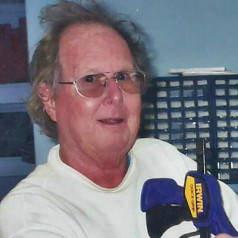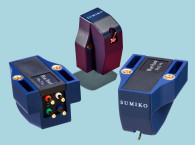Stroboscopes have probably been around since the first turntables were produced; that is, over 100 years. However, the earliest one I have has a copyright date of 1934. It was printed and given away by the Universal Microphone Company, Inglewood, Calif. It contains four bands: 78 RPM (25 or 50Hz), 78 RPM (60Hz), 33 1/3 RPM (25 or 50Hz), and 33 1/3 RPM (60Hz). The disc came in a cardboard folder and is shown on the left side of Photo 1.

Other Commercial Stroboscopes
Esoteric Sound(1) sells a 12-band stroboscope covering 16.67 to 90 RPM (for 60Hz). This disc is also shown in Photo 1. I’m not sure where the other disc in the photo came from because it has no company name. It is for 78 and 80 RPM (at 60Hz).
KAB ElectroAcoustics(2) offers a turntable speed tester, the KAB SpeedStrobe. It consists of a stroboscope printed on a 10" diameter, 20 mil thick PVC disc with a quartz crystal-controlled illuminator (60Hz) that is said to be 99.99% accurate. The illuminator is battery powered, so you can use it anywhere. The strobe disc is unique because instead of bars it has the rotational speed printed as numbers that you can read directly from the disc. It covers the following speeds: 16.66, 33.33, 45, and 70.59 to 90 RPM in 15 bands. The published specifications note that the speed accuracy can be measured to 0.03% by timing the drift of the display for one minute. Photo 2 shows the disc and illuminator.

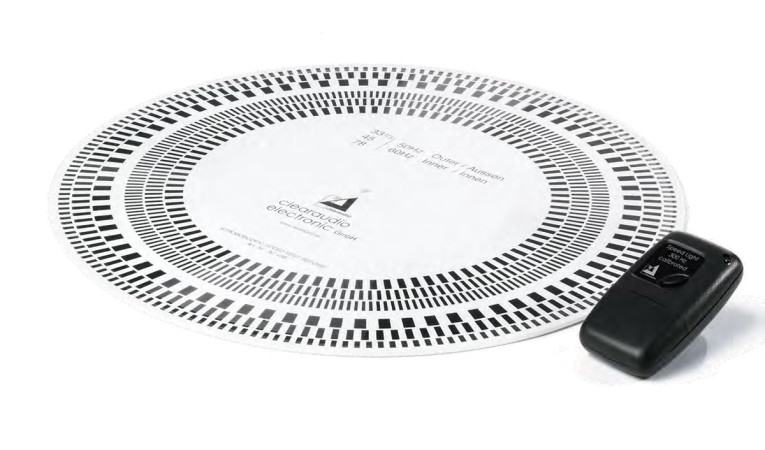
Clearaudio(3) has a speed strobe test LP and light bundle. You can play the two-sided strobe disc like a regular LP so that stylus drag can be taken into account when setting the turntable speed. One side of the disc is for 33 1/3 RPM, and the other side is for 45 RPM. It does not work for 78 RPM records. The illuminator is quartz-crystal controlled (300Hz), battery operated, and sold separately, so you could easily use it with any stroboscope disc for improved measurement accuracy. The bundle is pictured in Photo 3. Because the light flashes at 300Hz, you can use it with any stroboscope disc on turntables operating on 50Hz or 60Hz power.

Hifi4music(4) markets the DIGIstrobo, which is a rotational speed measuring device adapted to audio use; that is, it directly reads and displays the turntable speed so it can be used for all records from 33 1/3 to 90 or higher RPM. The published accuracy is ±0.05% (or 0.1 RPM). You can check the speed while playing a record if you provide something for the DIGIstrobo to “see.” A small piece of reflective tape on the turntable edge will work, and a supply of tape is furnished with the unit.
You can also use the device to measure speed stability. After a ten-minute or so turntable warmup, press the DIGIstrobo’s memory store button. It automatically captures the last speed, the maximum speed, and the minimum speed. It is pictured in Photo 4.
Do It Yourself
These days it’s not necessary to buy a stroboscope disc if you have a computer, because you can easily print your own for any speed and for either 50 or 60Hz power. There are two public domain programs: one is named strobe.exe and it’s an MS-DOS program which will run under Windows. It will print up to five strobe bands on a single sheet but the bars are a bit “jagged.” Both programs are available for free from several websites, including the TDL site(5). The zip file, strobe.zip, contains both executable programs with documentation. Figure 1 shows an example printout from strobo.exe: the outside diameter of the bars is over 7", which makes it easier to see whether the bar edges appear stationary.


It’s a good idea to print on at least 67 pound stock (or heavier), because you want the disc to lie flat on your turntable. You can easily trim your printed stroboscope to a round disc with a pair of scissors, but one problem remains: cutting the spindle hole in the center.
I solved this by building a “spindle holecutter” shown in Photo 5. Except for the inside diameter of the tubing, the dimensions aren’t critical. I measured the spindle diameters of all my turntables and found they were all nearly 0.28". So I chose brass tubing with an inside diameter of 0.316" (6).
I sharpened the lower end of the tubing with a file, and it can be re-sharpened as needed. I added the brass top cap (soldered on) to make it easier to hit with a mallet. To cut the hole, place your printed disc on a piece of smooth hardboard or wood, center the cutter over the printed hole, and hit the cutter cap with your mallet.
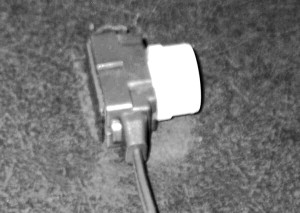
makes a usable but dim stroboscope lamp.
Incandescent lamps (ordinary light bulbs with a filament) work, but not too well. The filament does not cool very much between cycles of the AC power so the light output is rather constant. Fluorescent lamps are about the same. The phosphor coating on the inside of the tube continues to radiate light between the AC power cycles. You can see the stationary appearing bars, but their edges look fuzzy, so it’s difficult to set the speed “right on.”
Neon lamps and white LEDs operating on AC power work well because both produce pulses of light even though your eyes can’t really see the pulses, at least not with 60Hz power. You can use a neon “nightlight” (Photo 6), but it’s rather dim so it’s not too useful unless the room is dark! Better lamps are available.
For my use I built a multiple-LED lamp (Photos 7A and 7B). A circuit diagram with parts lists follows in Fig. 2. As you can see, the circuit is simple and the wiring is not at all critical. This lamp operates from a 12V AC wall transformer and the “bars” are much clearer than with an incandescent light. The cost of the parts was under $20.
You could also build a multiple-neon lamp, but the lamp firing voltages are different enough that individual current limiting resistors must be selected for each lamp. This makes construction a chore, so I decided to settle for the multiple-LED lamp, which works very well.
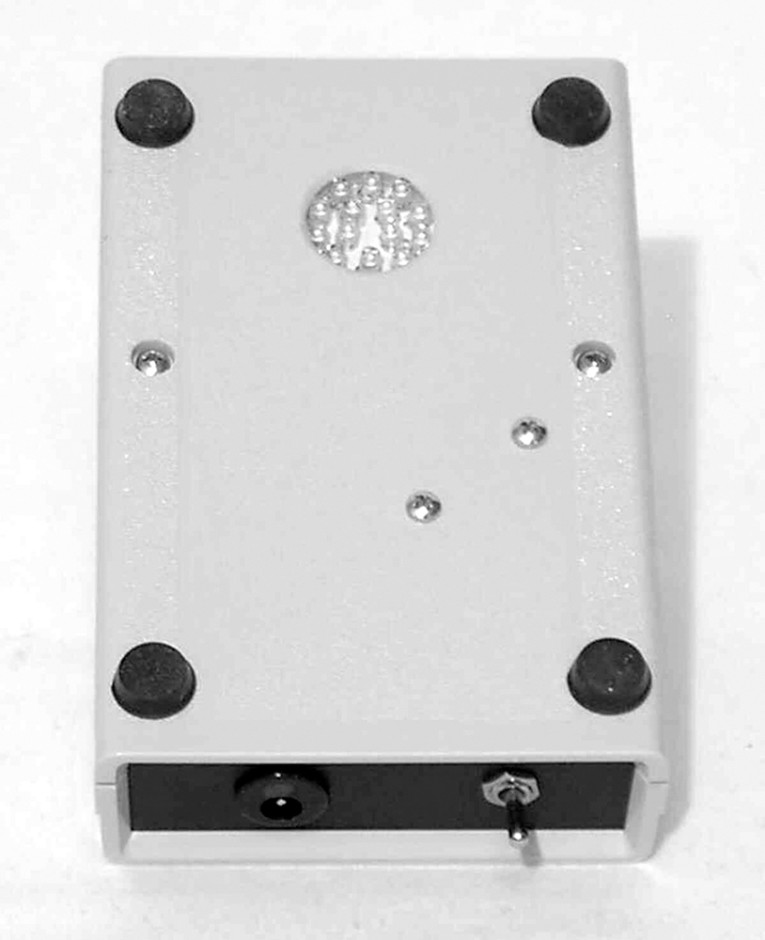
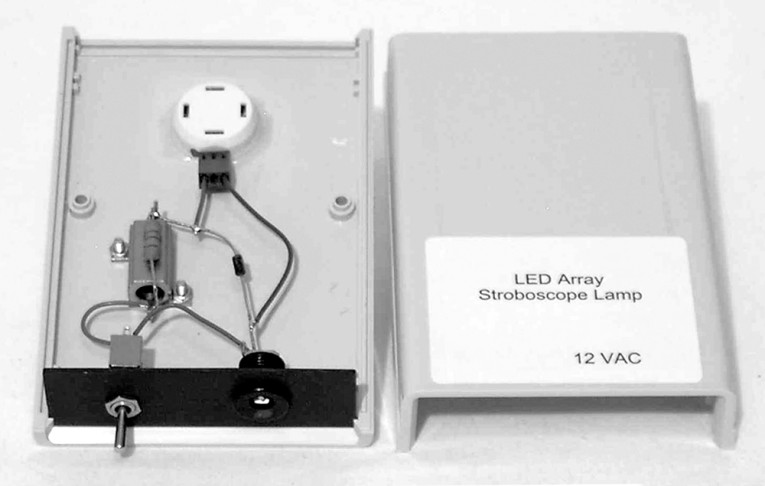

Some Final Thoughts
A stroboscope is useful, if for no other reason than periodically checking your turntable speed. Many modern turntables have “strobe bumps” cast or molded into the platter rim (Photo 8) which are useful for 33 1/3 and 45 RPM records. These may suffice if you never play 78s, but 78s were recorded at so many different speeds that multi-speed strobe discs or a DIGIstrobe is essential.
How important is it to set the speed while actually playing a record? That is, how much does stylus drag slow the speed? With today’s high-torque motors and low tracking force cartridges the answer is: probably not much. Perhaps if you have “golden ears,” you can hear the difference, but for most of us all we need is to get the speed as initially close as we can. aX

References
1. Esoteric Sound, 1608 Hemstock Ave. ,Wheaton, IL 60189, 630-933-9801, www.esotericsound.com.
2. KAB Electro-Acoustics, PO Box 2922, Plainfield, NJ 07062, 908-754-1479, www.kabusa.com.
3. Contact Music Direct for Clearaudio products (clearaudio.de), 318 N. Laffin St., Chicago, IL 60607, www.musicdirect.com.
4. (no longer in business)
5. www.tdl-tech.com/strobe.zip.
6. A similar brass tubing with a 0.405" OD is available from McMaster-Carr, 9630 Norwalk Blvd., Santa Fe Springs, CA 90670, 562-692-5911, www.mcmaster.com as part number 4501K71.
7. Marlin P. Jones and Associates, Inc., PO Box 530400, Lake Park, FL 33403, 800-652-6733, www.mpja.com.
8. The PacTec enclosure type CM3-100 is available from Mouser Electronics, 800-346-6873, www.mouser.com as part number 616-
71914-510-039.
This article was originally published in audioXpress, December 2010.


